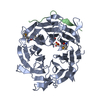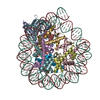[English] 日本語
 Yorodumi
Yorodumi- PDB-8siy: Origin Recognition Complex Associated (ORCA) protein bound to H4K... -
+ Open data
Open data
- Basic information
Basic information
| Entry | Database: PDB / ID: 8siy | |||||||||
|---|---|---|---|---|---|---|---|---|---|---|
| Title | Origin Recognition Complex Associated (ORCA) protein bound to H4K20me3-nucleosome | |||||||||
 Components Components |
| |||||||||
 Keywords Keywords |  REPLICATION / REPLICATION /  chromatin binding / ORC binding / chromatin binding / ORC binding /  nucleosome nucleosome | |||||||||
| Function / homology |  Function and homology information Function and homology informationActivation of ATR in response to replication stress / Assembly of the ORC complex at the origin of replication / CDC6 association with the ORC:origin complex / Activation of the pre-replicative complex / Orc1 removal from chromatin /  origin recognition complex / inner kinetochore / establishment of protein localization to chromatin / nuclear origin of replication recognition complex / methyl-CpG binding ...Activation of ATR in response to replication stress / Assembly of the ORC complex at the origin of replication / CDC6 association with the ORC:origin complex / Activation of the pre-replicative complex / Orc1 removal from chromatin / origin recognition complex / inner kinetochore / establishment of protein localization to chromatin / nuclear origin of replication recognition complex / methyl-CpG binding ...Activation of ATR in response to replication stress / Assembly of the ORC complex at the origin of replication / CDC6 association with the ORC:origin complex / Activation of the pre-replicative complex / Orc1 removal from chromatin /  origin recognition complex / inner kinetochore / establishment of protein localization to chromatin / nuclear origin of replication recognition complex / methyl-CpG binding / origin recognition complex / inner kinetochore / establishment of protein localization to chromatin / nuclear origin of replication recognition complex / methyl-CpG binding /  DNA replication origin binding / DNA replication initiation / DNA replication origin binding / DNA replication initiation /  heterochromatin / pericentric heterochromatin / methylated histone binding / heterochromatin / pericentric heterochromatin / methylated histone binding /  kinetochore / structural constituent of chromatin / kinetochore / structural constituent of chromatin /  nucleosome / chromatin organization / nucleosome / chromatin organization /  DNA replication / DNA replication /  chromosome, telomeric region / chromosome, telomeric region /  cytoskeleton / protein heterodimerization activity / cytoskeleton / protein heterodimerization activity /  centrosome / centrosome /  chromatin binding / chromatin binding /  chromatin / chromatin /  nucleolus / nucleolus /  DNA binding / DNA binding /  nucleoplasm / nucleoplasm /  nucleus / nucleus /  cytoplasm cytoplasmSimilarity search - Function | |||||||||
| Biological species |   Rattus norvegicus (Norway rat) Rattus norvegicus (Norway rat) Xenopus laevis (African clawed frog) Xenopus laevis (African clawed frog)synthetic construct (others) | |||||||||
| Method |  ELECTRON MICROSCOPY / ELECTRON MICROSCOPY /  single particle reconstruction / single particle reconstruction /  cryo EM / Resolution: 2.9 Å cryo EM / Resolution: 2.9 Å | |||||||||
 Authors Authors | Bleichert, F. / Ekundayo, B.E. | |||||||||
| Funding support |  United States, European Union, 2items United States, European Union, 2items
| |||||||||
 Citation Citation |  Journal: EMBO J / Year: 2023 Journal: EMBO J / Year: 2023Title: A dual role for the chromatin reader ORCA/LRWD1 in targeting the origin recognition complex to chromatin. Authors: Sumon Sahu / Babatunde E Ekundayo / Ashish Kumar / Franziska Bleichert /  Abstract: Eukaryotic cells use chromatin marks to regulate the initiation of DNA replication. The origin recognition complex (ORC)-associated protein ORCA plays a critical role in heterochromatin replication ...Eukaryotic cells use chromatin marks to regulate the initiation of DNA replication. The origin recognition complex (ORC)-associated protein ORCA plays a critical role in heterochromatin replication in mammalian cells by recruiting the initiator ORC, but the underlying mechanisms remain unclear. Here, we report crystal and cryo-electron microscopy structures of ORCA in complex with ORC's Orc2 subunit and nucleosomes, establishing that ORCA orchestrates ternary complex assembly by simultaneously recognizing a highly conserved peptide sequence in Orc2, nucleosomal DNA, and repressive histone trimethylation marks through an aromatic cage. Unexpectedly, binding of ORCA to nucleosomes prevents chromatin array compaction in a manner that relies on H4K20 trimethylation, a histone modification critical for heterochromatin replication. We further show that ORCA is necessary and sufficient to specifically recruit ORC into chromatin condensates marked by H4K20 trimethylation, providing a paradigm for studying replication initiation in specific chromatin contexts. Collectively, our findings support a model in which ORCA not only serves as a platform for ORC recruitment to nucleosomes bearing specific histone marks but also helps establish a local chromatin environment conducive to subsequent MCM2-7 loading. | |||||||||
| History |
|
- Structure visualization
Structure visualization
| Structure viewer | Molecule:  Molmil Molmil Jmol/JSmol Jmol/JSmol |
|---|
- Downloads & links
Downloads & links
- Download
Download
| PDBx/mmCIF format |  8siy.cif.gz 8siy.cif.gz | 398.4 KB | Display |  PDBx/mmCIF format PDBx/mmCIF format |
|---|---|---|---|---|
| PDB format |  pdb8siy.ent.gz pdb8siy.ent.gz | 298.5 KB | Display |  PDB format PDB format |
| PDBx/mmJSON format |  8siy.json.gz 8siy.json.gz | Tree view |  PDBx/mmJSON format PDBx/mmJSON format | |
| Others |  Other downloads Other downloads |
-Validation report
| Arichive directory |  https://data.pdbj.org/pub/pdb/validation_reports/si/8siy https://data.pdbj.org/pub/pdb/validation_reports/si/8siy ftp://data.pdbj.org/pub/pdb/validation_reports/si/8siy ftp://data.pdbj.org/pub/pdb/validation_reports/si/8siy | HTTPS FTP |
|---|
-Related structure data
| Related structure data |  40522MC  8siuC C: citing same article ( M: map data used to model this data |
|---|---|
| Similar structure data | Similarity search - Function & homology  F&H Search F&H Search |
- Links
Links
- Assembly
Assembly
| Deposited unit | 
|
|---|---|
| 1 |
|
- Components
Components
-Protein , 6 types, 10 molecules ACGDHEIFJB
| #1: Protein | Mass: 71651.547 Da / Num. of mol.: 1 Source method: isolated from a genetically manipulated source Source: (gene. exp.)   Rattus norvegicus (Norway rat) / Gene: Lrwd1 / Production host: Rattus norvegicus (Norway rat) / Gene: Lrwd1 / Production host:   Trichoplusia ni (cabbage looper) / References: UniProt: A0A140UHX1 Trichoplusia ni (cabbage looper) / References: UniProt: A0A140UHX1 | ||||||||
|---|---|---|---|---|---|---|---|---|---|
| #2: Protein | Mass: 15303.930 Da / Num. of mol.: 2 Source method: isolated from a genetically manipulated source Source: (gene. exp.)  Xenopus laevis (African clawed frog) / Production host: Xenopus laevis (African clawed frog) / Production host:   Escherichia coli (E. coli) / References: UniProt: P84233 Escherichia coli (E. coli) / References: UniProt: P84233#3: Protein |  Mass: 11323.350 Da / Num. of mol.: 2 Source method: isolated from a genetically manipulated source Source: (gene. exp.)  Xenopus laevis (African clawed frog) / Gene: LOC121398084 / Production host: Xenopus laevis (African clawed frog) / Gene: LOC121398084 / Production host:   Escherichia coli (E. coli) / References: UniProt: A0A8J1LTD2 Escherichia coli (E. coli) / References: UniProt: A0A8J1LTD2#4: Protein |  / Histone H2A type 1 / Histone H2A type 1Mass: 13962.241 Da / Num. of mol.: 2 Source method: isolated from a genetically manipulated source Source: (gene. exp.)  Xenopus laevis (African clawed frog) / Production host: Xenopus laevis (African clawed frog) / Production host:   Escherichia coli (E. coli) / References: UniProt: P06897 Escherichia coli (E. coli) / References: UniProt: P06897#5: Protein |  / H2B1.1 / H2B1.1Mass: 13524.752 Da / Num. of mol.: 2 Source method: isolated from a genetically manipulated source Source: (gene. exp.)  Xenopus laevis (African clawed frog) / Production host: Xenopus laevis (African clawed frog) / Production host:   Escherichia coli (E. coli) / References: UniProt: P02281 Escherichia coli (E. coli) / References: UniProt: P02281#8: Protein | |  Mass: 11570.101 Da / Num. of mol.: 1 Source method: isolated from a genetically manipulated source Source: (gene. exp.)   Rattus norvegicus (Norway rat) / Gene: Orc2, Orc2l / Production host: Rattus norvegicus (Norway rat) / Gene: Orc2, Orc2l / Production host:   Trichoplusia ni (cabbage looper) / References: UniProt: Q75PQ8 Trichoplusia ni (cabbage looper) / References: UniProt: Q75PQ8 |
-DNA chain , 2 types, 2 molecules KL
| #6: DNA chain | Mass: 46998.945 Da / Num. of mol.: 1 Source method: isolated from a genetically manipulated source Source: (gene. exp.) synthetic construct (others) / Production host:   Escherichia coli (E. coli) Escherichia coli (E. coli) |
|---|---|
| #7: DNA chain | Mass: 47457.234 Da / Num. of mol.: 1 Source method: isolated from a genetically manipulated source Source: (gene. exp.) synthetic construct (others) / Production host:   Escherichia coli (E. coli) Escherichia coli (E. coli) |
-Details
| Has ligand of interest | Y |
|---|
-Experimental details
-Experiment
| Experiment | Method:  ELECTRON MICROSCOPY ELECTRON MICROSCOPY |
|---|---|
| EM experiment | Aggregation state: PARTICLE / 3D reconstruction method:  single particle reconstruction single particle reconstruction |
- Sample preparation
Sample preparation
| Component |
| ||||||||||||||||||||||||
|---|---|---|---|---|---|---|---|---|---|---|---|---|---|---|---|---|---|---|---|---|---|---|---|---|---|
| Molecular weight | Experimental value: NO | ||||||||||||||||||||||||
| Source (natural) |
| ||||||||||||||||||||||||
| Source (recombinant) |
| ||||||||||||||||||||||||
| Buffer solution | pH: 7.5 | ||||||||||||||||||||||||
| Specimen | Embedding applied: NO / Shadowing applied: NO / Staining applied : NO / Vitrification applied : NO / Vitrification applied : YES : YES | ||||||||||||||||||||||||
| Specimen support | Grid material: GOLD / Grid type: UltrAuFoil R1.2/1.3 | ||||||||||||||||||||||||
Vitrification | Instrument: FEI VITROBOT MARK IV / Cryogen name: ETHANE |
- Electron microscopy imaging
Electron microscopy imaging
| Experimental equipment |  Model: Titan Krios / Image courtesy: FEI Company |
|---|---|
| Microscopy | Model: FEI TITAN KRIOS |
| Electron gun | Electron source : :  FIELD EMISSION GUN / Accelerating voltage: 300 kV / Illumination mode: FLOOD BEAM FIELD EMISSION GUN / Accelerating voltage: 300 kV / Illumination mode: FLOOD BEAM |
| Electron lens | Mode: BRIGHT FIELD Bright-field microscopy / Nominal defocus max: 2200 nm / Nominal defocus min: 1000 nm Bright-field microscopy / Nominal defocus max: 2200 nm / Nominal defocus min: 1000 nm |
| Image recording | Electron dose: 51 e/Å2 / Film or detector model: GATAN K3 (6k x 4k) |
- Processing
Processing
| Software | Name: PHENIX / Version: 1.20.1_4487: / Classification: refinement |
|---|---|
CTF correction | Type: PHASE FLIPPING AND AMPLITUDE CORRECTION |
3D reconstruction | Resolution: 2.9 Å / Resolution method: FSC 0.143 CUT-OFF / Num. of particles: 31420 / Symmetry type: POINT |
| Refinement | Cross valid method: NONE |
 Movie
Movie Controller
Controller


 PDBj
PDBj











































